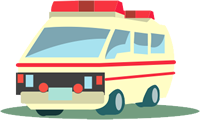HOME > Coughing and Wheezing
Coughing and Wheezing
The respiratory tract is the passage between the nose and the lungs. Coughing is caused when the body tries to push out phlegm, saliva or foreign objects stuck in the respiratory tract. If your child is coughing but does not have difficulty breathing, there is no need to immediately seek medical help. Wheezing is a whistling or crowing sound which can be heard when someone is breathing. It is usually heard when there is some kind of inflammation in the respiratory tract.
If your child is showing only mild symptoms (as listed below) during the night or on holidays, you should consult your pediatrician the following business day.
- (S)he is in a good mood and acting normal.
- (S)he can lie down and sleep.
- (S)he sometimes coughs or wheezes but does not have difficulty breathing.
- (S)he sometimes has a “barky” cough.
If your child has the following symptoms on a weekday during operating hours, seek medical attention. At night or on a holiday, please consult with a doctor by phone. There are some cases where visiting your pediatrician can wait until the following day, and some cases where a night visit is necessary.
- (S)he makes whistling sounds (stridor) when taking in a breath and looks distressed.
- (S)he has a “barky” cough and his/her voice can barely be heard due to hoarseness.
- (S)he cannot lie down or move due to breathing difficulties.
- (S)he has a sudden bout of strong coughing possibly due to a small object (peanuts, small toy parts, etc.) lodged in his/her throat and coughing continues. (There are cases in which your child should be taken to a hospital by ambulance.)
Call an ambulance (119) in case of any of the following situations.
- Your child’s face and lips look blue or purple in color (cyanosis).
- A decrease in the frequency of breaths taken.
- Your child seems to have difficulty breathing and his/her shoulders are moving up and down.
- The area above and between your child’s ribs caves in when (s)he breathes.
※Normal frequency of breath (per minute)
New born: 40–50 times
Infants: 30–40 times
Toddlers: 20–30 times

What can you do at home when your child is coughing or wheezing?
Make sure that the air in the room is not too dry.
Dryness in the air may induce coughing. You should keep a certain degree of humidity in the air by hanging laundry in the room or using a humidifier (guideline: 20˚ Celsius room temperature and 60% humidity). Keeping a wet towel next to your child’s pillow is also effective. If your child does not have a fever and is in good spirits, it is a good idea for him/her to take a bath.
Keep the air in the room clean.
You should ventilate the room by opening the windows from time to time. You should also keep linens (futon, sheets, etc.) and clothes clean.
Give your child a small amount of fluid at a time.
While coughing continues, make sure that your child drinks fluid in small amounts. It is common for a child to vomit after coughing. Position your child on his/her side when lying down to avoid the risk of choking on his/her own vomit.
Cigarette smoke may induce coughing.
Cigarette smoke damages the windpipe. If your child is exposed to cigarette smoke on a daily basis, his/her windpipe becomes more susceptible to the influence of smoke and coughing may be induced. You should make sure that no one smokes in the same room as your child.
* If your child has been diagnosed with bronchial asthma, follow your doctor’s directions.
